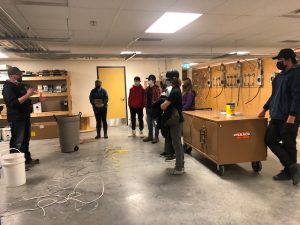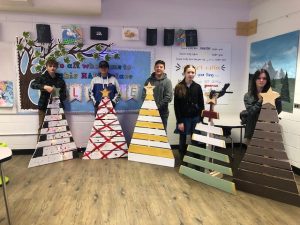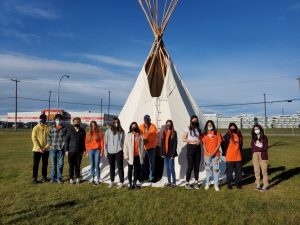I. General Information
School Name: Bert Bowes Middle School
School District: SD#60 Peace River North
Inquiry Team Members: Melanie Carew: mcarew@prn.bc.ca, Moneca Conway: mconway@prn.bc.ca
Inquiry Team Contact Email: mcarew@prn.bc.ca
II. Inquiry Project Information
Type of Inquiry: NOIIE Transitions (focus on Indigenous learner transitions)
Grade Levels Addressed Through Inquiry: Secondary (8-12)
Curricular Areas Addressed: Applied Design, skills & Technology, Career Education, Mathematics / Numeracy
Focus Addressed: Indigenous understandings (for example, Traditional Knowledge, oral history, reconciliation), Community-based learning, Core competencies (for example, critical thinking, communication, problem solving), Differentiated instruction, Experiential learning, First Peoples Principles of Learning, Flexible learning, Growth mindset, Inclusion and inclusive instructional strategies, Indigenous pedagogy, Inquiry-based learning, Social and emotional learning, STEM / STEAM, Transitions, Universal design for learning
In one sentence, what was your focus for the year? Our focus was to help students ease their transition from middle school to high school, by providing them with opportunities to learn more about careers that might interest them.
III. Spirals of Inquiry Details
Scanning: I conduct learning journeys with all of my Grade 9 Indigenous learners. These are self reflections to see where a student is now and where they see themselves in the future. We do it as an interview style where I ask the questions and jot down their answers. I have incorporated the four key questions into the Learning Journey. Looking back at the results, 90% of the students could name two adults in their current school who believe they will be a success. This tells us that we have built a connection with our students and have worked with them to find success both in and out of school.
Focus: We have been focusing on transitions for our Indigenous Learners from middle school to high school for a few years. Our team noticed it was difficult for students to leave one school where they built adult connections, and start at a new one in Grade 10 where the adults were strangers to them. Our hope was to build a connection for Grade 9 students and adults from their future high school. We connected with the Careers Coordinator on a biweekly basis and did several things with her like ADST projects, visits to the local college and fire department, and learning from an Elder. Our goal was to equip our students with skills that they could use in high school and beyond, as well as build a meaningful connection with an adult at their future school.
Hunch: Many of our students have expressed that what they were learning in the classroom was not relevant to them and what they wanted to do in the future. Our goal was to engage students and give them an opportunity to see if what they were learning in their classes was helpful with a possible career path they wanted to take. We took them to our local college where they met with nursing and trades instructors and were able to see what a college classroom looks like. Meeting with these instructors and their students was beneficial for our students to see first hand that what they were currently learning was the basis for what these students were putting into practice at the college level.
New Professional Learning: There are some resources that we have been using to help us facilitate career activities with our groups such as Skills Canada, myBlueprint, and UBC Geering Up Engineering Outreach at geeringup.apsc.ubc.ca. We also incorporated more learning from members of our local community, such as the FSJ Fire Department and Northern Lights College. We also had the privilege to share our space with an Elder who spoke about transitions in life and overcoming obstacles with our students.
Taking Action: We met with two groups of Grade 9 Indigenous students on a bi-weekly basis. These visits consisted of either ADST activities or field trips within the community. We visited their future Grade 10 campus on a number of occasions. They met with staff from various departments, visited dual-credit programs, and were able to become familiar with a new and much larger school. The ADST activities we chose to do were based on student interests. The students did woodworking, sewing/textiles, metal work, baking, etc. Students also wanted to learn more about what our local college has to offer. This was such a beneficial experience for our students to see first hand their interest in careers at a college level. When working with an Elder, students made ribbon skirts and shirts, as well as listened to the knowledge she was offering to them about her life experiences and the world around them.
Photo (left): Students with an interest in woodwork made pallet Christmas trees as gifts for family members.
Photo (middle): Students with an interest in various trades had the opportunity to visit an electrical and instrumentation classroom at Northern Lights College.
Photo (right): On September 30th, Grade 9 Indigenous learners helped out up a tipi in our school’s field and had the opportunity to hear stories from Elders.
Checking: We have been doing this inquiry for a few years now. We think that we have found success based on the continued connection Melanie has with students when they leave middle school, and the connection they continue to build with Moneca in high school. Students continue to communicate with us their struggles, as well as their achievements in school and beyond.
Reflections/Advice: We want to continue this inquiry into next year with a new cohort of Grade 9 students. We are hopeful that we can partake in more off-campus visits within the community, and build on Indigenous learning as COVID protocols has lessened recently. Our goal is that students feel a sense of belonging and importance in school and that this doesn’t change when they transition from one school to the next on their learning journey.



